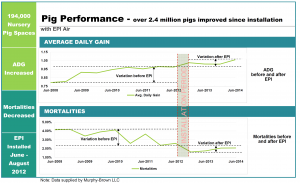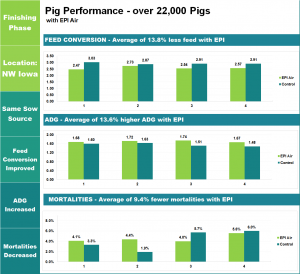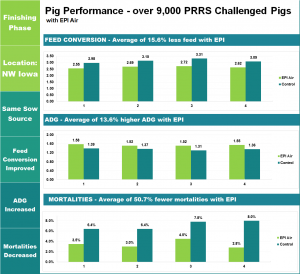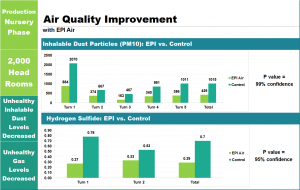K-State Research: EPI Air Improves Pig Growth - Comprehensive Review
View the Webinar here
(Results available by clicking on teal text or picture)
Already a trusted production tool for improving pig performance, EPI Air has proven in studies time and time again to significantly reduce morbidity and mortality rates. It’s simple: Clean air is better. Tracking 20 consecutive months of system-wide commercial performance while producing 2.4 million nursery pigs shows an ADG increase of 10.3 percent and mortality rates reduced by nearly half, from 3.35 percent to 1.86 percent. *
An additional study performed in Northwestern Iowa was performed with over 22,000 healthy finishing pigs and over 9,000 PRRS challenged pigs. Using the same sow source Feed Conversion improved, ADG increased and mortalities decreased. *



Air Quality Improvements
Respiratory diseases are responsible for a significant amount of animal morbidity and mortality in the swine industry, including the majority of nursery and grower/finisher deaths. A recent Quarantine Project in Canada is studying new ways that a bio-containment system could be adapted for a swine barn. This innovative quarantine project used a combination of EPI Air and filtration to achieve promising results. Bacteria concentrations were 10 times less in the EPI Air room vs. the Control Room.*
Newly released data from the University of Minnesota proves that the electrostatic particle ionization technology used in EPI Air systems removes 83 to 95 percent of air-borne pathogens in and around swine barns, including PED, PRRS and influenza viruses.*
Results of a study in a production rooms with 2,000 head of nursery pigs showed a 58% decrease in inhalable dust particles(PM10) and a decrease of 59% in hydrogen sulfide.*
*Actual producer results may vary.




EPI Air is the only available technology that can scrub disease-causing particulates from barn air, a new dimension of biosecurity never before attainable: Swine barn air cleansed of disease-causing agents with significant reduction in viable pathogens exhausted through barn ventilation.
